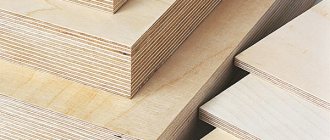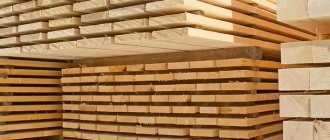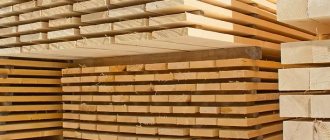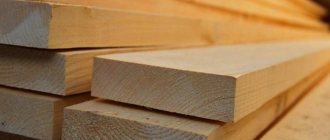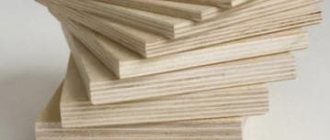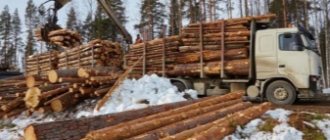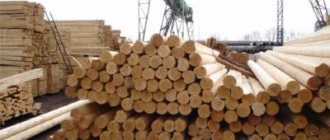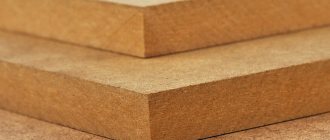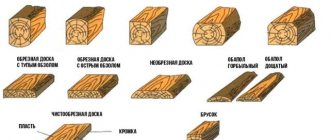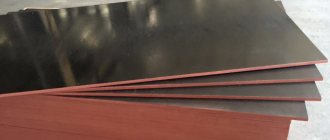Today, the use of lumber is in great demand in the construction industry. This is not surprising, since wood is a durable and environmentally friendly material. And thanks to modern technologies and processing means, the tree will last for decades.
Types of cutting: 1-tangential, 2-radial.
Types of log cutting
- transverse - the log is sawn across the wood fibers, such processing is typical for the production of decorative parquet;
- semi-radial - the wood is cut at an acute angle to the fibers, after which it is used for flooring;
- radial - the cut is made strictly in the middle of the trunk. The boards obtained using this method have high strength, beautiful patterns and resistance to external factors;
- tangential - made a little further from the middle in order to achieve an elegant natural pattern.
Each type of cut is widely used in the procurement of lumber in construction.
Lumber sizes
Boards and timber
Standardization of dimensions is needed to be able to calculate the required amount of material for a specific job.
Lumber is produced in sizes:
- lining, flooring and edged boards - width 65 - 275 mm, length 1000 - 6000 mm (gradation 250 mm), thickness 16 - 75 mm;
- bars and beams - width 40 - 275 mm, length 1000 - 6000 mm, thickness 40 - 275 mm;
- rail — 25 x 50 mm, 25 x 40 mm, 20 x 40 mm, 22 x 50 mm;
- picket fence - length 500 - 1800 mm, width 40 - 100 mm, thickness 16 - 40 mm;
- plinth — length 1000 – 2000 mm, width 15 – 60 mm, height 40 – 80 mm;
- glazing bead - length 1000 - 2000 mm, width 8 - 10 mm, thickness 10 mm.
Dimensions are taken at product humidity of 20% . Tolerances of 5 mm are allowed in length and 1–3 mm in thickness.
Types of lumber
For the production of lumber, trunks of deciduous and coniferous trees are used, which, after felling, are cleared of bark and branches. Based on the shape, type, type of wood and methods of its processing, a classification of lumber has been developed.
The traditional classification includes the following types of lumber:
- Timber is a building material that is obtained by cutting off the edges of a log to give it a square or rectangular shape. Such products are used for the construction of load-bearing structures, windows, doors and stairs. The thickness of the timber is at least 10 cm.
- Bars are small pieces of wood that are used in construction, furniture production and finishing work. They can have different dimensions, shape and degree of processing.
- Board - represents the next stage of timber processing. The use of these lumber is planned based on the thickness and degree of surface treatment.
- Sleepers are highly specialized lumber that is widely used in railway construction.
- A slab is a type of board that is flat on one side and convex and semicircular on the other. It is used as facade cladding for decorative purposes. A type of slab is a block house, along the edges of which there are grooves for fastening during finishing facade work.
- Obapol - made from the outer parts of the log, waste from timber production. It has smooth and swollen sides; if necessary, it can be cleared of bark.
- Rounded logs - the use of lumber of this type is typical for the construction of houses (log houses). For assembly, only straight tree trunks of a specific diameter without branches are used. The log making process removes the bark and outer layers of wood. The material is given an ideal shape, after which grooves, or locks, are cut into it. The logs, like a constructor, are assembled along grooves, which ensures amazing structural strength. Log houses are distinguished by high aesthetic properties, and they do not require interior finishing.
- Profiled timber - the basis for it is ordinary timber, on which connecting ditches are cut by planing or milling. The structures of this material are also highly durable and have a long service life with proper care. Among the advantages of buildings made from such timber, there is no need to prepare a powerful foundation.
- Glued laminated timber is made from boards by gluing and pressing them. These lumber are strong and durable, which justifies their frequent use in the construction of ideally shaped houses.
Classification of lumber products. Dimensions, markings, characteristics of lumber
For lumber products in accordance with GOST 18288-87 “Sawmill products. Terms and definitions" include lumber, blanks, obapol, slab and sleepers. Lumber products are obtained from coniferous, hard and soft deciduous wood as a result of longitudinal division of the log into parts and longitudinal and transverse cutting of the resulting parts.
Lumber - assortments of standard sizes obtained by cutting logs, sorted by size and quality and used in their entirety or for the production of blanks, parts and wood products.
Lumber is characterized by dimensions of length, width and thickness, the determination of which is carried out by direct measurement. The length of lumber is measured in meters, width and thickness - in millimeters.
In all lumber, face, edge and edge are distinguished (Fig. 1).
The face is the widest part of the lumber; it can be internal or external.
The edge is the narrowest part of the lumber, and the edge is between the face and the edge. The length of the face is limited by the ends , and the distance along the face between the two edges is its width.
The length of lumber is measured by the shortest distance between the ends, the thickness - between the inner and outer face, and the width - along the width of the face.
The width of unedged lumber is calculated as half the sum of the width of the inner and outer faces, measured in the middle of the length of the lumber.
In edged lumber, sharp and blunt wane are distinguished (Fig. 1), which are considered processing defects. A sharp wane is located on the edge and is an unacceptable defect; a blunt wane is located partly on the edge and partly on the face; it degrades the quality of edged lumber and is standardized in fractions of length.
Rice. 1. Elements of lumber: 1 – outer face; 2 – rib; 3 – edge; 4 – acute wane; 5 – end; 6 – internal surface; 7 – blunt wane; h – thickness; b, b1, b2 – width; l – length
By species, sawn assortments are divided into:
- produced from certain coniferous species;
- produced from certain hardwoods;
- produced from all coniferous and deciduous species.
According to the shape and cross-sectional dimensions, lumber products are divided into types:
- boards;
- bars;
- bars
Boards are lumber up to 100 mm thick and more than twice the width. The wide sides are called the face. Narrow - edged. The thickness of the board is determined by the distance between the layers, the width - by the distance between the edges. The length of the board is measured along the grain between the ends. End - the end cross section of the material. The line of intersection of the face and the edge is called an edge.
Timber – lumber with a thickness and width of more than 100 mm. According to the number of sawn or milled sides, the beams are:
- two-edged,
- three-edged (vanches),
- four-edged;
according to the cross-sectional shape - acute-edged and obtuse-edged. Ostrokanting beams have a rectangular or square shape, and at the upper end obtuse angles are allowed, taking into account the wane. Tupocant beams have wanes at the ends - the remaining part of the side surface of the log.
Lumber – lumber, with the exception of aviation timber, having a thickness of up to 100 mm and a width of no more than double the thickness, i.e. up to 200 mm.
Obapol is a lumber product obtained from the side of a log and having one sawn and the other unsawn, or one sawn and the other partially sawn surface. The croaker obapole has one of the surfaces sawn through no more than half the length. The plank floor has one of the sides sawn through more than half the length.
Sleepers are lumber in the form of a bar, having a cross section (intended for laying under railway rails).
Flat bars, thin narrow boards are called slats. Thin and short lumber with a rectangular cross-section are called planks and planks.
According to the nature of processing, lumber is divided into unedged, edged and one-sided edged (GOST 18288 - 88 “Sawmill products. Terms and definitions”).
Edged is lumber with parallel faces and edges sawn perpendicular to the faces, and with a wane of no more than permissible.
Unedged is lumber with parallel facets and unsawed or partially sawn edges with a wane that is more acceptable in edged lumber.
Single-sided edged lumber has sawn faces and one edge, and the dimensions of the wane of the unsawed edge do not exceed those allowed for edged lumber.
According to the nature of processing of the longitudinal sides, the beams are divided into two-, three- and four-edge (Fig. 2). The sawn-off side parts of logs are called slabs . They are used to produce obapol, intended to strengthen mining operations.
According to the location of the layers relative to the annual layers, sawn products are divided into radial, tangential and mixed sawing. For radial production, the layers run perpendicular to the annual layers, i.e., they are directed along the radii of the cross section of the logs, while for the tangential layer they are located tangentially to the annual layers. These types of products are classified as special, but the bulk of sawn products are produced without taking into account the location of the annual layers and are classified as mixed sawing products.
Rice. 2. Types of lumber: a, b, c – two-, three- and four-edge beams, respectively; g – unedged board; d – single-sided edged board; e – edged board; g – edged board with sharp wane; h – block; ; and – both sexes croaker; k – both floor planks; l – edged sleeper; m – unedged sleeper
Based on the location of the lumber in the log (in relation to the longitudinal axis), core, central and side boards are distinguished. The core board (beam) is cut from the central part of a log or beam and includes a core. Central boards are cut from the central part of a log or beam and are located symmetrically to the axis of the assortment. Side boards are obtained by sawing from the side of a log.
According to the types of sawing, lumber is divided into two groups: group and individual sawing.
Group sawing is used in the mass production of lumber without taking into account the shape defects of each log. When individual sawing, a distinction is made between radial and tangential sawn lumber. The first ones are obtained by oriented sawing of logs or beams with a predominant direction of cuts close to the radii of the annual layers of wood. The latter are obtained by oriented sawing of logs with a predominant direction of cuts tangential to the annual layers of wood.
Depending on the place of sale, lumber is distinguished between export and domestic consumption .
Lumber for domestic consumption is divided into two subgroups: lumber for general and special purposes. The latter include aviation lumber (GOST 968) and obapol for fastening mine workings (GOST 5780), boards for barrel stave (GOST 247 and GOST 5661), military removable boards.
General purpose lumber is produced according to unified GOST standards.
Hardwood lumber is made from ridges and logs of all hard and soft hardwood trees in accordance with GOST 2695 “Hardwood lumber. Technical conditions". According to cross-sectional dimensions, they are divided into bars and boards, which can be thin (up to 32 mm) and thick (from 35 mm or more). The nominal dimensions of lumber are established:
by lenght:
- from hard hardwood from 0.5 to 6.5 m with a gradation of 0.10 m;
- from soft deciduous trees and birch from 0.5 to 2.0 m with a gradation of 0.10 m; from 2.0 to 6.5 m with gradation of 0.25 m;
- thickness - 19, 22, 25, 32, 40, 45, 50, 60, 70, 80, 90, 100 mm;
in width:
- edged - 60, 70, 80, 90, 100, 110, 130, 150, 180, 200 mm;
- unedged and one-sided edged - 50 mm or more with gradation of 10 mm.
The width of the narrow face in unedged lumber should not be less than 40 mm.
The nominal dimensions of lumber in terms of thickness and width are established for wood with a moisture content of 20%. When the moisture content is more or less than 20%, the dimensions of lumber must be set taking into account the amount of shrinkage in accordance with GOST 6782.2 “Lumber products from deciduous wood. The amount of shrinkage."
The maximum deviations from the nominal dimensions are set as follows:
- length, mm: +50; — 25
- in thickness, mm: up to 32 ±1.0; more than 35 ±2.0
- by width of edged lumber, mm: up to 100 ±2.0; more than 100 ±3.0
Lumber is produced dry (with a moisture content of no more than 22%), raw (with a moisture content of more than 22%) and raw antiseptic. Antiseptic treatment - according to GOST 10950 “Lumber and blanks. Antiseptic treatment by immersion."
The symbol must consist of
- names of the subject of standardization (lumber, board, block, timber);
- numbers indicating the variety;
- names of wood species;
- digital designation of the cross section and standard designation,
For example:
TIMBER – 2 OAK – 40×60 GOST 2695.
Softwood lumber is made from pine, spruce, fir, larch and cedar. GOST 8486 “Softwood lumber. Technical conditions".
The dimensions of lumber in terms of thickness and width are regulated by GOST 24454 “Softwood lumber. Dimensions for wood with a moisture content of 20%" (see Table 1). When the wood moisture content is different from 20%, the actual dimensions of thickness and width must be more or less than the nominal dimensions for the corresponding amount of shrinkage in accordance with GOST 6782.1 “Lumber from softwood. The amount of shrinkage."
The width of the narrow face, measured anywhere along the length of unedged lumber, should be:
- for thickness from 16 to 50 mm not less than 50 mm
- for thickness from 60 to 100 mm not less than 60 mm
- for thicknesses from 125 to 300 mm, at least 0.6 thickness.
Table 1. Dimensions of softwood lumber
| Thickness | Width | ||||||||
| 16 | 75 | 100 | 125 | 150 | — | — | — | — | — |
| 19 | 75 | 100 | 125 | 150 | 175 | — | — | — | — |
| 22 | 75 | 100 | 125 | 150 | 175 | 200 | 225 | — | — |
| 25 | 75 | 100 | 125 | 150 | 175 | 200 | 225 | 250 | 275 |
| 32 | 75 | 100 | 125 | 150 | 175 | 200 | 225 | 250 | 275 |
| 40 | 75 | 100 | 125 | 150 | 175 | 200 | 225 | 250 | 275 |
| 44 | 75 | 100 | 125 | 150 | 175 | 200 | 225 | 250 | 275 |
| 50 | 75 | 100 | 125 | 150 | 175 | 200 | 225 | 250 | 275 |
| 60 | 75 | 100 | 125 | 150 | 175 | 200 | 225 | 250 | 275 |
| 75 | 75 | 100 | 125 | 150 | 175 | 200 | 225 | 250 | 275 |
| 100 | — | 100 | 125 | 150 | 175 | 200 | 225 | 250 | 275 |
| 125 | — | — | 125 | 150 | 175 | 200 | 225 | 250 | — |
| 150 | — | — | — | 150 | 175 | 200 | 225 | 250 | — |
| 175 | — | — | — | — | 175 | 200 | 225 | 250 | — |
| 200 | — | — | — | — | — | 200 | 225 | 250 | — |
| 250 | — | — | — | — | — | — | — | — | — |
The width of the face of edged lumber with non-parallel edges in a narrow place should be:
- for thicknesses from 16 to 50 mm not less than 50 mm
- for thicknesses from 60 to 100 mm not less than 60 mm
- for thicknesses from 125 to 300 mm, at least 0.7 thickness.
The nominal length dimensions of lumber are established:
- for the domestic market and export - from 1.0 to 6.5 m with a gradation of 0.25 m;
- for the manufacture of containers - from 0.5 m to 0.1 m gradations;
- for bridge beams – 3.25;
- only for export – 0.9 to 6.3 m with gradation of 0.3 m.
Maximum deviations from nominal dimensions are established:
- length, mm: +50; — 25
- in thickness, mm: up to 32 ±1.0; from 40 to 100 ±2.0; more than 100 ±3.0
- width for edged lumber, mm: up to 100 ±2.0; more than 100 ±3.0
For lumber less than 1.5 m long, maximum length deviations are not established.
Based on the quality of wood and processing, boards and bars are divided into five grades (selected - 1, 2, 3, 4th), and beams - into four grades (1, 2, 3, 4th). High-grade lumber is produced dry (up to 22%), raw (more than 22%) and raw antiseptic.
Main purposes of lumber:
- 0, 1st grade - special shipbuilding - for plating and ties of sea boats, boats, seagoing vessels, laying external and internal decks, etc.;
- 0, 1, 2nd grade – agricultural machinery – for parts of agricultural machines;
- 0, 1, 2, 3rd grade – carriage building – for parts of railway cars, shipbuilding, automotive industry – for the manufacture of wooden parts for truck platforms, trailers, etc., bridge building, wagon building;
- 1, 2, 3rd grade – construction and repair and construction needs, parts for windows and doors, planed parts, parts for wooden houses, etc., production of various woodworking parts, including furniture, riveting for barrels;
- 3, 4th grade – containers and packaging;
- 4th grade – for use on minor parts in construction, cutting into small pieces for various purposes.
The symbol must consist of the name of the lumber (board, block, timber), a number indicating the grade, the name of the wood species (coniferous or a separate species), a digital designation of the cross section (for unedged lumber - thickness) and a designation of the standard.
BOARD – 2 – PINE – 32×100 – GOST 8486-86
BOARD – 2 – xv. – 32 – GOST 8486-86
The maximum permissible defects are in most cases the same for softwood and hardwood lumber. Thus, in 4 grades of coniferous lumber and 3 grades of deciduous lumber, the following are allowed without restrictions: healthy intergrown knots, including dark ones, mushroom core spots, sapwood mushroom stains, mold, bending of fibers, sprouting, cancer, pockets.
In low-grade lumber, cracks are allowed without restrictions: in coniferous wood, cracks (except for end ones), in deciduous wood, partially fused and unfused, rotten, rotten and tobacco knots.
The highest grades of coniferous and deciduous lumber have the same restrictions on rot, knots, cracks and some other defects. Thus, the size of fused knots is allowed up to 1/3 of the width of the face, partially fused and unfused – up to 1/5. Rotten, rotten and tobacco knots, mushroom core stains are not allowed.
The surface roughness parameters of deciduous and coniferous lumber should not exceed 1250 microns for the highest grades, and 1600 microns for the 3rd and 4th grades, respectively.
Labeling, packaging and transportation of lumber is carried out in accordance with GOST 6564-84 “Lumber and blanks. Acceptance rules, control methods, marking and transportation" and GOST 19041-85 "Packages and block packages of lumber products. Formation, packaging, labeling, transportation and storage.”
Export lumber is produced from coniferous wood.
Black Sea sorted lumber is produced from spruce, fir and pine wood in accordance with GOST 9302 “Black Sea sorted softwood lumber supplied for export”.
Depending on the cross-sectional dimensions and length, lumber is called:
- normal (width from 170 to 300 mm and length 4 m and from 4.25 to 6.5 m),
- sottomizura (width from 100 to 160 mm and length as normal),
- morals (bars of square cross-section) and half-morals (bars of rectangular cross-section, length as normal),
- cortals (short lumber of all sections with a length from 1.0 to 3.75 m),
- madrieri (long lumber from 3.0 to 6.5 m and thickness from 70 to 220 mm).
The gradation along the length of all lumber is 0.25 m. The thickness of lumber is 18, 22, 24, 28, 35, 38, 45, 48, 58, 65 (66), 70, 76, 96, 124, 150, 220 mm. The width of lumber, depending on the type, ranges from 70 to 300 mm. Based on quality, they are divided into ungraded, 4th and 5th grades. Their humidity should not be more than 20%, the parameters of surface roughness of the 5th grade are 1600 mm, the rest - no more than 800 microns.
Northern sorted lumber is produced in accordance with GOST 36002-83 “Northern sorted softwood lumber supplied for export. Technical conditions" for export through the White Sea, Far Eastern, St. Petersburg and Igarsk ports. They are divided:
by thickness:
- for thin ones – from 16 to 22 mm,
- for medium ones – from 25 to 44 mm,
- for thick ones – from 50 to 100 mm;
in width:
- for narrow ones from 75 to 125 mm
- for wide ones – 150 mm and above;
by lenght:
- for short ones - from 0.45 to 2.40 m,
- for long ones - from 2.70 to 6.30 m.
The nominal dimensions of lumber in terms of thickness and width are established according to GOST 24454-80 “Softwood lumber. Dimensions". In this case, their thickness should not exceed 100 mm.
The dimensions of lumber along the length are set: from 1.5 m and more with a gradation of 0.3 m, from 0.45 to 1.35 m with a gradation of 0.15 m.
Based on the quality of wood and its processing, they are divided into 1st, 2nd, 3rd grades (unsorted) and 4th, 5th grades (utcots). Longer than 2.7 m are sorted into ungraded and separately 4th and 5th grades, less – into ungraded and 4th grade together, 5th grade – separately.
Storage of lumber is regulated by GOST 3808.1-80 “Softwood lumber. Atmospheric drying and storage", GOST 7319-80 "Lumber and hardwood blanks. Atmospheric drying and storage" and sets itself the task of protecting wood from cracking, warping, and the action of fungi and insects. Preservation of properties and protection of wood can be achieved by drying, surface impregnation, preservation, etc.
Preparations of coniferous and deciduous species . Blanks a certain quality that have allowances for subsequent processing for the manufacture of certain products and structures.
Depending on the type of workpiece processing, there are:
- sawn – made by sawing;
- calibrated - pre-planed;
- glued – obtained by gluing together smaller pieces of length, width or thickness.
In terms of size, the workpieces can be single or multiple, with an allowance for division. Depending on the design of future products, blanks are divided into:
- lumber (with certain dimensions in thickness, width and length, for example, window sashes);
- molded (with certain dimensions in thickness and width, but free in length, for example, plinth, cornice, lining);
- panel boards (with certain dimensions in thickness and length, but free in width, for example, containers, flooring, partitions).
According to their purpose, blanks are divided into special and general purpose. Technical requirements for each type of special workpiece are regulated by the relevant GOST, for example:
- GOST 48 “Ski blanks”,
- GOST 2800-83 “Blanks for wooden parts of horse-drawn cart wheels”,
- GOST 16423 “Blanks for stocks of sporting and hunting weapons”,
- GOST 12457 “Wooden blanks for oars”, etc.
Technical requirements for general-purpose blanks are regulated by GOST 7897 “Blanks of hardwood” and GOST 9685 “Blanks of softwood”.
Blanks with a wood moisture content of 15% have the following dimensions, mm:
- – conifers – thickness 7, 10, 13, 16, 19, 22, 25, 32, 40, 50, 60, 75, 100, width – 40, 50, 60, 70, 75, 80, 90, 100, 110, 130, 150, 180, 200;
- – deciduous – thickness 19, 22, 25, 32, 40, 45, 50, 60, 70, width – 40, 45, 50, 60, 70, 80, 90, 100, 110, 130, 150.
Blanks for piece parquet (GOST 7897-83) can be produced with a width of 40-70 mm with a gradation of 5 mm and a length of 0.17-0.47 m with a gradation of 50 mm.
The unified dimensions of rough furniture blanks according to TU 13-566-85 are given in table. 2.
Table 2. Dimensions of rough furniture blanks (CHB)
| Thickness | Width | Length | |||||||||||
| Blanks for the manufacture of upholstered furniture, mm: | |||||||||||||
| Coniferous | |||||||||||||
| 19 | — | 50 | 60 | — | 75 | — | 90 | — | — | — | 300 | 850 | 900 |
| 25 | — | 50 | 60 | 70 | 75 | — | 90 | 100 | 110 | 130 | 1000 | 1100 | 1200 |
| 32 | 40 | 50 | 60 | 70 | 75 | 80 | 90 | 100 | 110 | 130 | 1300 | 1400 | 1500 |
| 40 | 40 | 50 | 60 | 70 | 75 | 80 | 90 | 100 | 110 | 130 | 1600 | 1700 | 1800 |
| 50 | — | 50 | 60 | 70 | 75 | 80 | 90 | 100 | — | 130 | 1900 | 2000 | — |
| Hardwood | |||||||||||||
| 16 | — | 50 | — | — | — | — | — | — | — | — | 900 | 950 | 1000 |
| 19 | — | 50 | — | — | — | — | — | — | — | — | 1100 | 1200 | 1300 |
| 22 | — | — | 60 | — | 80 | — | — | — | — | — | 1400 | 1500 | 1600 |
| 25 | 40 | 50 | 60 | 70 | 80 | — | — | — | — | — | 1700 | 1800 | 1900 |
| 32 | 40 | 50 | 60 | 70 | 80 | 90 | 100 | 110 | — | — | 2000 | — | — |
| 40 | — | 50 | 60 | 70 | 80 | 90 | — | 110 | — | — | — | — | — |
| 50 | — | 50 | 60 | — | — | — | — | — | — | — | — | — | — |
| Blanks for the manufacture of cabinet furniture, mm | |||||||||||||
| Coniferous | |||||||||||||
| 19 | — | 50 | 60 | — | 75 | — | 90 | 110 | — | — | 800 | 850 | 900 |
| 25 | — | 50 | 60 | 70 | 75 | — | 90 | 100 | 110 | 130 | 950 | 1000 | 1100 |
| 32 | 40 | 50 | 60 | 70 | 75 | 80 | 90 | — | — | — | 1200 | 1300 | 1400 |
| 40 | — | — | — | 70 | — | 80 | 90 | — | — | — | 1500 | 1600 | 1700 |
| 50 | — | 50 | 60 | 70 | — | — | — | — | — | — | 1800 | 1900 | 2000 |
| Hardwood | |||||||||||||
| 25 | 40 | 50 | 60 | — | — | — | — | — | — | — | 900 | 950 | 1000 |
| 32 | 40 | 50 | 60 | 70 | — | — | — | — | — | — | 1100 | 1200 | 1300 |
| 40 | 40 | 50 | 60 | — | 80 | — | — | — | — | — | 1400 | 1500 | 1600 |
| 50 | — | 50 | 60 | — | — | — | — | — | — | — | 1700 | — | — |
| Coniferous and deciduous wood blanks species for making carpentry chairs, mm | |||||||||||||
| 16 | — | 50 | — | — | — | — | — | — | — | — | 450 | 500 | 700 |
| 19 | — | 50 | — | — | — | — | — | — | — | — | 750 | 800 | 850 |
| 22 | 40 | 50 | 60 | 70 | 80 | — | — | — | — | — | 900 | 950 | 1000 |
| 25 | 40 | 50 | 60 | 70 | 80 | — | — | — | — | — | Not further regulated | ||
| 32 | 40 | 50 | 60 | 70 | 80 | 90 | 100 | 110 | 130 | — | |||
| 40 | 40 | 50 | 60 | 70 | 80 | 90 | 100 | 110 | 130 | — | |||
| 50 | — | 50 | — | — | — | — | — | — | — | — | |||
Blanks with a thickness of 7-75 mm and a width of more than double the thickness are called board, and with a thickness of 22 to 100 mm and a width of no more than double the thickness - block. Blanks with a length from 0.5 (deciduous from 0.3) to 1 m have a gradation of 50 mm, with a length over 1 m the gradation is 100 mm. Delivery of blanks of multiple lengths is allowed. Birch and soft hardwood blanks can be used as softwood substitutes.
For transportation by all types of transport, the workpieces are formed into packages in accordance with the requirements of GOST 16369 “Transport packages of timber. Dimensions".
Coniferous wood harvesting is divided into groups based on wood quality and processing. Blanks of the 1st group are intended for parts for transparent finishing of small front parts of joinery and construction products, furniture, parquet, in shipbuilding, automobile and carriage building. Blanks of the 2nd and 3rd quality groups are used for the manufacture of critical parts coated with opaque paints, and parts for cladding (window sashes, trim, agricultural engineering parts, furniture parts). Blanks of the 4th group are produced for less critical and loaded parts (bars of window and door frames, floor boards, cladding for opaque painting, etc.)
Deciduous wood blanks are produced in grades 1, 2 and 3 and are used for the same purpose as softwood blanks.
The quality of blanks is checked in accordance with GOST 6564 “Lumber and blanks. Acceptance rules, control methods, labeling and transportation.” Laying, storage, antiseptic and protection of workpieces are similar to lumber.
Workpieces of all lengths must be marked. Conventional signs of grades or quality groups are applied to one of the ends or to the face using a stamp and indelible paint. Vertical stripes are applied to ends up to 25 mm thick, and for larger thicknesses, dots are applied in accordance with table. 3.
When marking selected and first grade lumber for shipbuilding, the letter “C” is added to the mark indicating the grade (for example, 0C or IC). When marking workpieces intended for equipment construction, the letter “O” is additionally applied, for skis – the letter “L”, for resonant ones – the letter “P”.
Table 3. Designation of the variety when labeling
| Variety | Designation | ||
| paint | chalk | ||
| lumber | blanks | ||
| Selected | One horizontal stripe (-) | 0 | |
| 1 | One dot or vertical stripe ( . or I) | I | 1 |
| 2 | Two dots or two vertical stripes (... or II) | II | 2 |
| 3 | Three dots or three vertical stripes (... III) | III | 3 |
| 4 | Not marked | ||
When loading or shipping lumber or blanks in batches, it is allowed to mark the faces of lumber and blanks with wash-resistant chalk or a stamp; a tag measuring 80×120 mm made of plywood is attached to each package. The tag indicates the package number, the manufacturer and its address, the name of the product (variety, group, quality, breed, size), quantity in cubic meters, for example, the product standard and the number assigned to the quality control inspector.
Sawn parts refer to products suitable in size and quality for the manufacture of products and structures without any processing. These are parts for making containers, beams for construction, etc.
In addition to lumber and blanks, sawmills and woodworking enterprises produce waste from the main production - sawdust, as well as slabs, lump residues and trimmings. From them, by grinding, by-products are obtained - technological chips, which are used to produce cellulose, wood boards, feed yeast, alcohol, etc.
502
Classification of lumber by grade
Selected variety. The materials do not have pronounced defects, traces of knots, or deep cracks due to drying out of the logs. There may be a small number of healthy knots: 2 per 1 m of the product. It is used to create premium pieces of furniture and for finishing luxury cars.
First grade. Provides for a greater number of knots and cracks. The material should not be rotten, rotten or moldy. Used in construction.
Second grade. Deep cracks and small wormholes are allowed. Rottenness and rot are excluded. Such lumber is used in construction and the furniture industry.
Third grade. A small amount of rot, wormholes over the entire surface and through cracks are allowed. The material is used for the construction of sheds, commodity pallets, and boxes.
Fourth grade. This includes low-class wood, which is used to create structures and objects that do not require strength and durability.
Material for production
The primary raw material for lumber production is tree trunks. They are subject to advance cleaning of branches and bark. The material can be either coniferous or deciduous trees. The latter are often used as lumber for finishing premises and buildings. Coniferous trees are used for the construction of load-bearing structures. The production of lumber has virtually no waste, since it is a valuable recyclable material that is used for industrial and domestic purposes.
Some of the available types of wood that are used to make lumber are birch and poplar. Common tree species are pine, spruce, linden, ash, maple, and larch. The most industrially significant wood is hornbeam, oak, and cedar.
Birch is considered a fairly light material; it has an unusual structure and reasonable cost.
Larch is used to produce a moisture-resistant product that is resistant to fungus and mold.
Ash wood has excellent elasticity and high strength properties.
Oak is used to create furniture, stairs, and floors because it has good strength characteristics. This is an aesthetically beautiful and quite durable material. It is quite popular, even despite the high cost.
Combustible materials that can catch fire include pine.
Spruce is a flexible and soft material that can be easily processed.
Where is lumber used?
This building material is involved in almost all spheres of human life. However, most wood is still used in the construction of buildings, the manufacture of furniture, as well as in interior and exterior finishing work. To improve the natural properties, wood is often treated with chemicals, which make it resistant to moisture, fungus, mold, fire resistance - and extend its service life.
More about construction and renovation
All articles
Pros and cons of lumber
Humanity has been surrounded by wooden products for many centuries. Wood was used to create residential buildings, churches, baths and similar buildings. In addition to the premises, window frames, tables, chairs, cabinets, beds, etc. were also created. This material is no less relevant today due to its characteristics. Below are the advantages and disadvantages of lumber.
Advantages:
- the material has a high load-bearing capacity, despite its low weight;
- characterized by simplicity and ease of processing (drilling, cutting, manufacturing of various shapes);
- minimal labor costs during installation;
- the natural composition ensures safety for humans and the environment and is not prone to cause an allergic reaction;
- material processing work does not require a lot of time and money;
- aesthetically pleasing material;
- the natural smell of wood has a beneficial effect on the indoor microclimate;
- lumber comes in many shapes and sizes;
- low cost of the product.
Flaws:
- the material can quickly ignite;
- susceptible to the influence of fungus, mold and insects;
- prolonged exposure to moisture leads to rotting processes.
To provide this building material with properties such as wear resistance and durability, it is treated with special materials. substances that protect lumber from negative external factors and the ability to quickly ignite.
General information about lumber
The term "lumber" implies a range of wood products of certain sizes and qualities.
Wooden products are made by dividing logs into pieces and then cutting them. The result is blanks, wooden parts and the lumber itself.
The category of lumber by assortment is divided into:
- Bars are products with a thickness of no more than 100 mm. The width is usually less than 200 mm. The bars are often used to make door frames. They are also used to level surfaces.
- Bars - have a width of more than 100 mm and are divided into two-, three- and four-edge.
- Croakers are remnants of the woodworking process. The product is a one-sided convex board. Croakers are used as a basis for the construction of fences, fences, subfloors, benches and design ideas.
- Obapoles are products obtained from the side part of a log after sawing it. This lumber is made from coniferous trees.
- Sleepers are large cross-section beams that are laid across the railroad bed.
The most popular type of wooden products are boards of various thicknesses and lengths.
Types of lumber by processing method:
- Faced - processed wood that has been given a specified length.
- Uncut - unprocessed from the end of the product.
- Calibrated - material dried to a certain moisture content and subsequently processed in accordance with the specified dimensions.
- Planed - obtained by planing one plane or two edges.
- Structural - materials made from hard wood (oak, larch).
According to the type of sawing, timber can be tangential and radial sawing. The first type of cut is made along tangents to the lines of the annual rings of the trunk at a short distance from the core. The second type is sawing, in which the cut is made through the core of the log.
General technical requirements
To determine the grade of edged and unedged lumber, there are generally accepted state standards.
Regulatory Requirements
Wood producers rely on the regulatory framework, which is regulated by such documents as GOST 24454-80, GOST 8486-86, GOST 2140-81, etc. All documentation is freely available, but some meanings are still incomprehensible to people far from the construction industry.
Since mostly softwood lumber ends up on construction sites, GOST 8486-86 is considered the most basic document.
Key excerpts worth paying attention to:
- Boards and bars are divided into 5 grades, bars - into 4.
- Wood moisture content should be no more than 22%. Drying wet wood is almost impossible.
- The roughness value parameter is set to 1250 microns, and for grade 4 - 1600 microns.
- The nominal length of the product should be 1.0-6.5 m, and deviations from it should be from -25 mm to + 50 mm.
GOST 8486-86 Softwood lumber. Specifications
1 file 440.08 KB
The grade of products is strongly influenced by the criterion for limiting natural wood defects. The general list of required parameters according to GOST is more than 30 items.
Norms and restrictions of natural vices
Each type of wood has its own standards and restrictions on natural defects. These characteristics are given in GOST in the form of a table.
GOST 24454-80 Softwood lumber. Dimensions
1 file 109.25 KB
Excerpts from the standards:
- Tree knots are divided into healthy, rotten, edge, and partially fused. Each type of wood has a strictly regulated number of knots.
- The slope of the fibers for the highest grade should not exceed 5%, otherwise the wood will be assigned grade 1.
- For selected wood, the presence of rot, mold, wormholes, fungal and cancer spots and foreign inclusions is unacceptable.
GOST 2140-81 Visible defects in wood. Classification, terms and definitions, methods of measurement
1 file 5.21 MB
There is also such a parameter as longitudinal warpage, which should be up to 0.20% of the width of the lumber.
